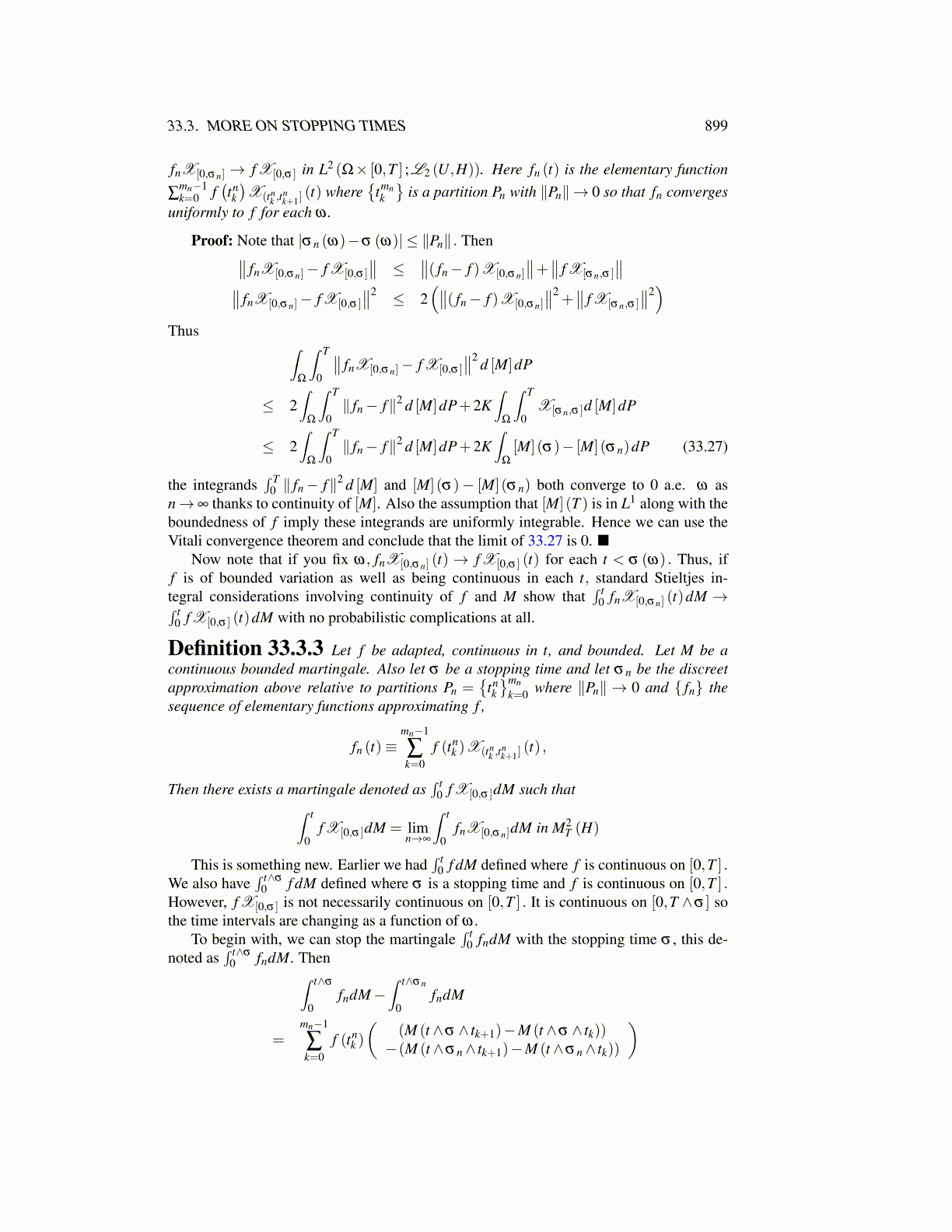
33.3. MORE ON STOPPING TIMES 899
fnX[0,σn] → f X[0,σ ] in L2 (Ω× [0,T ] ;L2 (U,H)). Here fn (t) is the elementary function
∑mn−1k=0 f
(tnk
)X(tn
k ,tnk+1]
(t) where{
tmnk
}is a partition Pn with ∥Pn∥→ 0 so that fn converges
uniformly to f for each ω .
Proof: Note that |σn (ω)−σ (ω)| ≤ ∥Pn∥ . Then∥∥ fnX[0,σn]− f X[0,σ ]
∥∥ ≤∥∥( fn− f )X[0,σn]
∥∥+∥∥ f X[σn,σ ]
∥∥∥∥ fnX[0,σn]− f X[0,σ ]
∥∥2 ≤ 2(∥∥( fn− f )X[0,σn]
∥∥2+∥∥ f X[σn,σ ]
∥∥2)
Thus ∫Ω
∫ T
0
∥∥ fnX[0,σn]− f X[0,σ ]
∥∥2 d [M]dP
≤ 2∫
Ω
∫ T
0∥ fn− f∥2 d [M]dP+2K
∫Ω
∫ T
0X[σn,σ ]d [M]dP
≤ 2∫
Ω
∫ T
0∥ fn− f∥2 d [M]dP+2K
∫Ω
[M] (σ)− [M] (σn)dP (33.27)
the integrands∫ T
0 ∥ fn− f∥2 d [M] and [M] (σ)− [M] (σn) both converge to 0 a.e. ω asn→∞ thanks to continuity of [M]. Also the assumption that [M] (T ) is in L1 along with theboundedness of f imply these integrands are uniformly integrable. Hence we can use theVitali convergence theorem and conclude that the limit of 33.27 is 0. ■
Now note that if you fix ω, fnX[0,σn] (t)→ f X[0,σ ] (t) for each t < σ (ω) . Thus, iff is of bounded variation as well as being continuous in each t, standard Stieltjes in-tegral considerations involving continuity of f and M show that
∫ t0 fnX[0,σn] (t)dM →∫ t
0 f X[0,σ ] (t)dM with no probabilistic complications at all.
Definition 33.3.3 Let f be adapted, continuous in t, and bounded. Let M be acontinuous bounded martingale. Also let σ be a stopping time and let σn be the discreetapproximation above relative to partitions Pn =
{tnk
}mnk=0 where ∥Pn∥ → 0 and { fn} the
sequence of elementary functions approximating f ,
fn (t)≡mn−1
∑k=0
f (tnk )X(tn
k ,tnk+1]
(t) ,
Then there exists a martingale denoted as∫ t
0 f X[0,σ ]dM such that∫ t
0f X[0,σ ]dM = lim
n→∞
∫ t
0fnX[0,σn]dM in M2
T (H)
This is something new. Earlier we had∫ t
0 f dM defined where f is continuous on [0,T ] .We also have
∫ t∧σ
0 f dM defined where σ is a stopping time and f is continuous on [0,T ] .However, f X[0,σ ] is not necessarily continuous on [0,T ] . It is continuous on [0,T ∧σ ] sothe time intervals are changing as a function of ω .
To begin with, we can stop the martingale∫ t
0 fndM with the stopping time σ , this de-noted as
∫ t∧σ
0 fndM. Then∫ t∧σ
0fndM−
∫ t∧σn
0fndM
=mn−1
∑k=0
f (tnk )
((M (t ∧σ ∧ tk+1)−M (t ∧σ ∧ tk))−(M (t ∧σn∧ tk+1)−M (t ∧σn∧ tk))
)